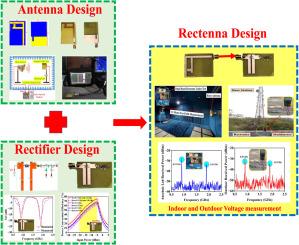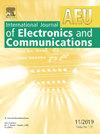采用双频整流天线的射频能量采集器设计,用于超低功耗电子系统
IF 3.2
3区 计算机科学
Q2 ENGINEERING, ELECTRICAL & ELECTRONIC
Aeu-International Journal of Electronics and Communications
Pub Date : 2025-07-30
DOI:10.1016/j.aeue.2025.155962
引用次数: 0
摘要
射频(RF)能量收集技术的出现已经成为一种可行的解决方案,作为低功耗电子设备的能量来源,包括物联网(IoT),无线传感器和微控制器单元(MCU)应用。本文介绍了一种紧凑的双频射频能量采集器,该采集器采用了一种新型的基于缺陷地面结构(DGS)的单极天线。它集成了一个pi型整流器。拟议的整流天线工作在0.9 GHz和1.8 GHz两个频段,对应于城市环境中大量存在的GSM频段。在−5 dBm输入时,系统的峰值功率转换效率(PCE)为68.94%。即使在−10 dBm的较低输入功率下,在0.9 GHz和1.8 GHz下的实测PCE值分别为54.74%和52.22%,显示了整流电路在低功率条件下的高灵敏度和高效率。此外,实验评估成功地在消声室中产生了- 11.2 dBm的0.606 V直流电压,在室外环境中产生了- 13.1 dBm的0.50 V直流电压。它建立了系统在现实世界场景中的有效性。该设计展示了卓越的性能,并引入了一种为实际能量收集应用量身定制的新方法。本文章由计算机程序翻译,如有差异,请以英文原文为准。

RF energy harvester design using a dual-band rectenna for ultra-low-power electronic systems
The advent of Radio Frequency (RF) energy harvesting technology has become a viable solution as an energy source for low-power electronic devices, including Internet of Things (IoT), wireless sensors, and microcontroller unit (MCU) applications. This article presents a compact dual-band RF energy harvester incorporating a novel Defected Ground Structure (DGS) based monopole antenna. It is integrated with a Pi-type rectifier. The proposed rectenna operates at two bands of 0.9 GHz and 1.8 GHz, corresponding to the GSM frequency bands, which are abundantly present in urban environments. The system achieves 68.94 % peak power conversion efficiency (PCE) for −5 dBm input. Even with a lower input power of −10 dBm, the measured PCE values are 54.74 % at 0.9 GHz and 52.22 % at 1.8 GHz, demonstrating the high sensitivity and efficiency of the rectification circuit under low-power conditions. Furthermore, experimental evaluations of the rectenna successfully generated a DC voltage of 0.606 V at −11.2 dBm in an anechoic chamber and 0.50 V at −13.1 dBm in an outdoor environment. It establishes the system’s effectiveness for real-world scenarios. This design demonstrates superior performance and introduces a novel approach tailored for practical energy harvesting applications.
求助全文
通过发布文献求助,成功后即可免费获取论文全文。
去求助
来源期刊
CiteScore
6.90
自引率
18.80%
发文量
292
审稿时长
4.9 months
期刊介绍:
AEÜ is an international scientific journal which publishes both original works and invited tutorials. The journal''s scope covers all aspects of theory and design of circuits, systems and devices for electronics, signal processing, and communication, including:
signal and system theory, digital signal processing
network theory and circuit design
information theory, communication theory and techniques, modulation, source and channel coding
switching theory and techniques, communication protocols
optical communications
microwave theory and techniques, radar, sonar
antennas, wave propagation
AEÜ publishes full papers and letters with very short turn around time but a high standard review process. Review cycles are typically finished within twelve weeks by application of modern electronic communication facilities.

 求助内容:
求助内容: 应助结果提醒方式:
应助结果提醒方式:


